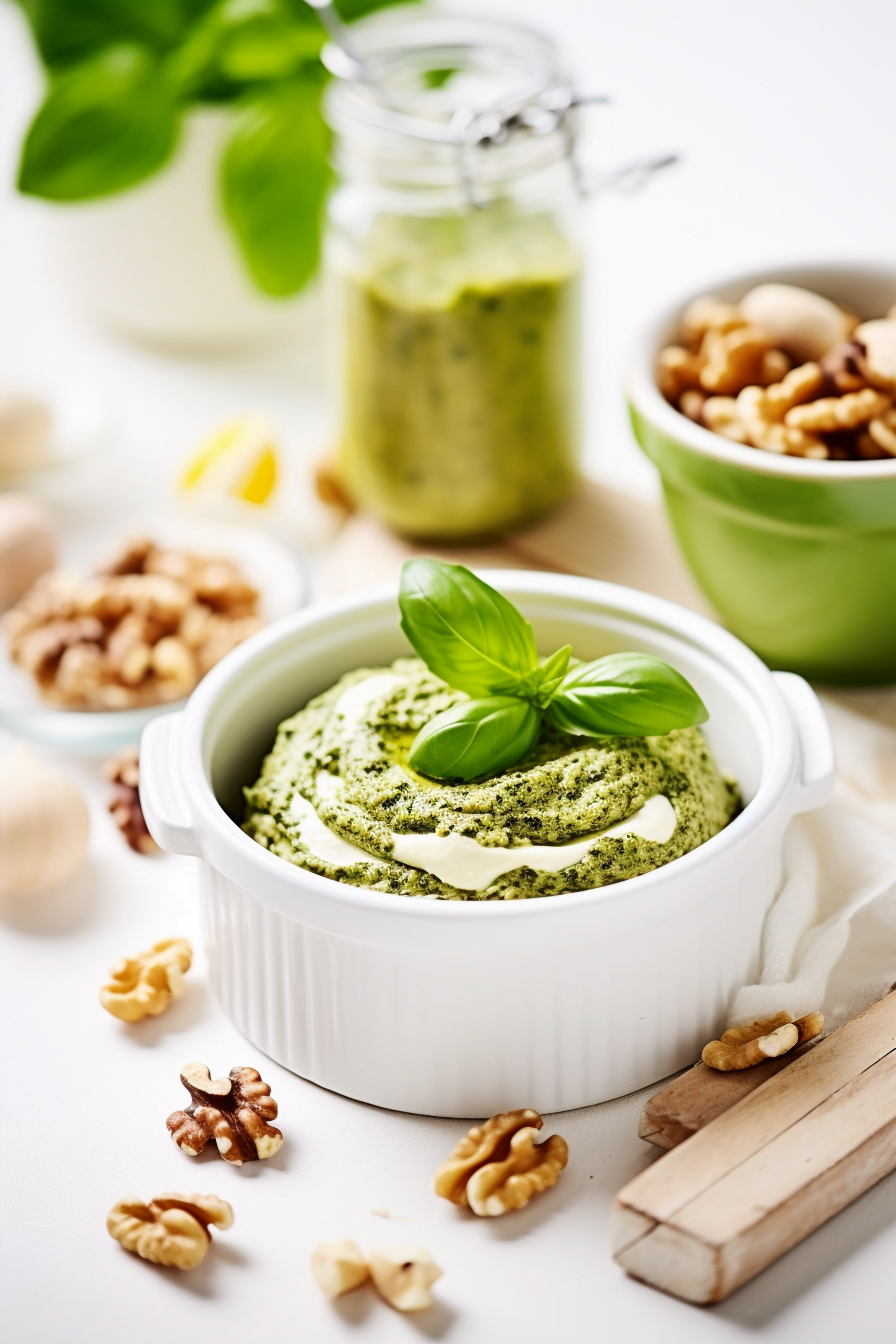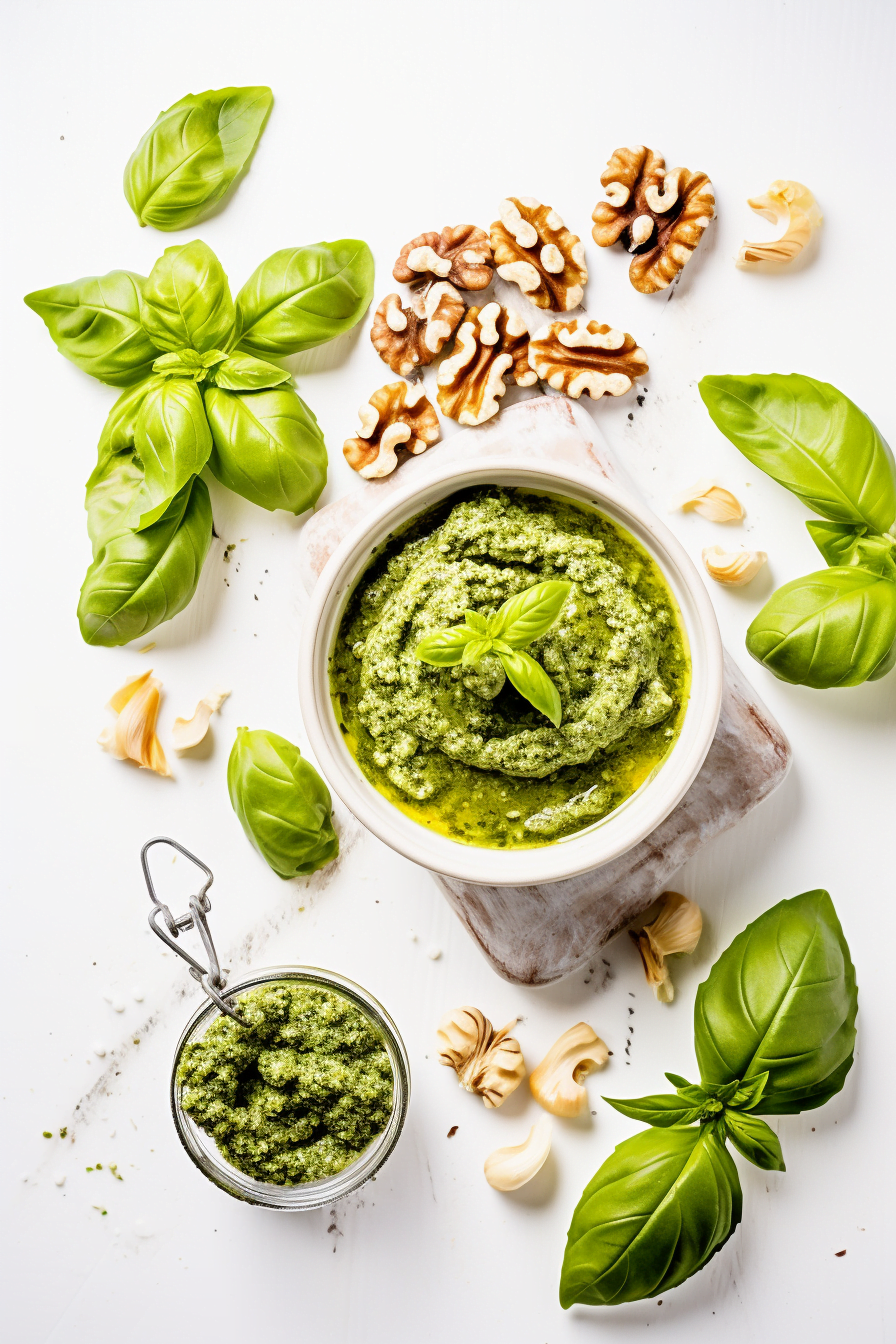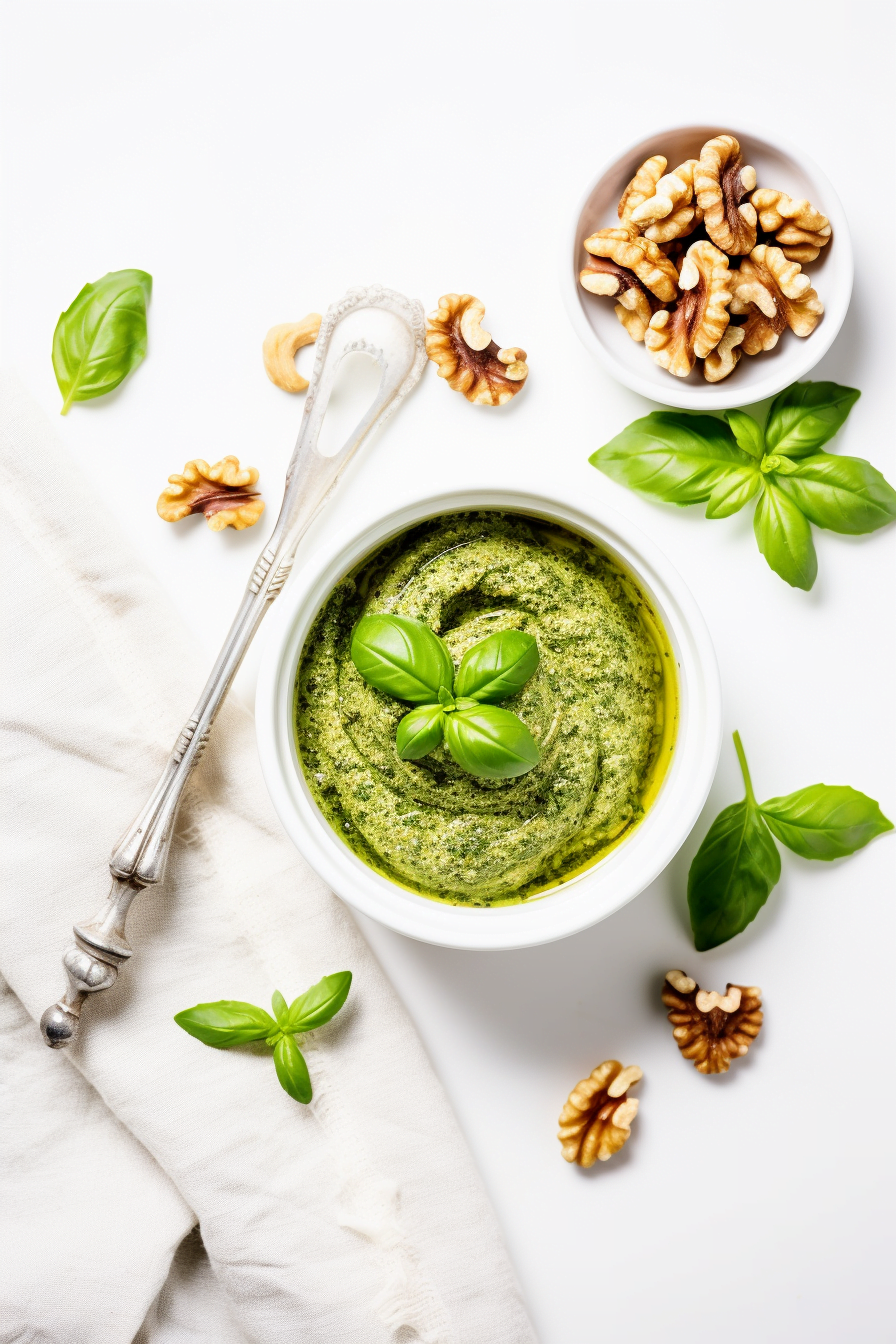Discover the Freshness of Italian Pesto Genovese with Walnut and Mint
Embark on a culinary journey to the heart of Liguria with our **Italian Pesto Genovese with Walnut and Mint**. This recipe is a refreshing twist on the traditional Genoese staple, incorporating the nutty richness of walnuts and the cool, vibrant notes of fresh mint. Whether you’re looking to elevate your pasta dishes or add a burst of flavor to sandwiches and salads, this homemade pesto is a versatile addition to your Mediterranean cooking repertoire.
With no cooking required, this pesto comes together in a mere **10 minutes**, making it a quick, yet impressive way to infuse your meals with the essence of Italian cuisine. Let’s delve into the simplicity of creating this delightful sauce that’s sure to become a staple in your kitchen.

The Ligurian Legacy with a Twist
The classic Pesto Genovese, hailing from the picturesque region of Liguria, is renowned for its combination of basil, pine nuts, and Parmigiano-Reggiano. Our version, however, draws inspiration from the versatility of Mediterranean ingredients, introducing walnuts and mint for a unique flavor profile. Walnuts, while not traditional in Ligurian pesto, are a staple in Italian cooking, often found in the regional dishes of Campania and Sicily, where they add depth and texture to sauces and desserts alike.
Mint, on the other hand, is a beloved herb across the Mediterranean, from the refreshing teas of Moroccan cuisine to the zesty salads of Greece. By infusing mint into our pesto, we pay homage to the herbaceous landscapes of Tuscany and Umbria, where mint grows wild and is used to enhance both sweet and savory dishes. This **Italian Pesto Genovese with Walnut and Mint** is more than just a sauce—it’s a celebration of the rich tapestry of flavors that define Mediterranean cuisine.
The inclusion of **fresh lemon juice** also nods to the Amalfi Coast, where citrus fruits are prized for their ability to brighten dishes. The combination of these elements results in a pesto that is both familiar and novel, offering a refreshing twist on a beloved classic.

Mastering the Method
Creating the perfect **Italian Pesto Genovese with Walnut and Mint** requires a balance of technique and intuition. Start by **toasting the walnuts** to unlock their aromatic oils and enhance their flavor. Be vigilant as nuts can burn quickly; you’re aiming for a golden hue and a warm, nutty scent.
When it comes to the basil and mint, ensure they are **thoroughly dried** after washing to prevent the pesto from becoming watery. Traditional Genovese pesto calls for a mortar and pestle to crush the leaves, releasing their oils gradually. While we use a food processor for convenience, consider pulsing rather than running it continuously to mimic the gentle bruising action of the pestle.
The **slow addition of extra virgin olive oil** is crucial. Pour it in a steady stream to emulsify with the herb and nut mixture, creating a silky and cohesive sauce. As for the cheese, Parmigiano-Reggiano is the gold standard, but be sure to add it last to maintain its texture and prevent clumping.
Finally, remember that pesto is an art, not a science. Taste as you go and adjust the seasoning to your preference. Whether you prefer a chunkier texture or a smoother sauce, the beauty of pesto lies in its adaptability.

Variations to Savor
Pesto with a Sicilian Touch
Embrace the Sicilian love for almonds by replacing walnuts with **toasted almonds**. The result is a pesto with a slightly sweeter edge, reminiscent of the almond orchards dotting the Sicilian landscape.
Herbaceous Calabrian Pesto
For a Calabrian twist, introduce a hint of heat by adding a small amount of **crushed red pepper flakes**. This nod to the region’s penchant for spice will add an exciting kick to the pesto’s flavor profile.
Tuscan Pesto with a Creamy Twist
Incorporate a touch of Tuscany by blending in a spoonful of **ricotta cheese** for a creamier texture. This variation is inspired by the creamy sauces often found in Tuscan pasta dishes.
Substitutions for Every Palate
**Nut-Free Pesto**: For those with nut allergies, consider using **sunflower seeds** as a nut alternative. They provide a similar texture and a mild, nutty flavor that complements the basil and mint.
**Cheese Alternatives**: If you’re catering to a vegan diet or are lactose intolerant, **nutritional yeast** can be an excellent substitute for Parmigiano-Reggiano, offering a cheesy flavor without the dairy.
**Oil Variations**: For a lighter version, you can opt for a **mixture of extra virgin olive oil and a neutral oil** like grapeseed. This will reduce the intensity of the olive oil while maintaining the pesto’s luscious texture.
Frequently Asked Questions
Can I freeze Italian Pesto Genovese with Walnut and Mint?
Yes, pesto freezes well. Pour it into ice cube trays, freeze, and then transfer the cubes to a freezer bag for easy portioning.
How long will homemade pesto last in the refrigerator?
Properly stored in an airtight container with a layer of olive oil on top, it can last for up to a week.
Can I use dried herbs instead of fresh?
Fresh herbs are essential for the vibrant flavor and color of pesto; dried herbs won’t provide the same results.
Is it necessary to toast the walnuts?
Toasting is recommended to enhance flavor, but you can skip this step if you’re short on time.
What can I serve with this pesto?
It’s versatile! Serve with pasta, as a spread for bruschetta, or as a dressing for salads.

Italian Pesto Genovese with Walnut and Mint
Equipment
- Food processor
- Skillet
- Measuring cups and spoons
- Kitchen towel or paper towels
- Airtight container (for storage)
Ingredients
- 2 cups Fresh basil leaves (48 grams)
- 1/2 cup Fresh mint leaves (12 grams)
- 1/3 cup Walnuts (40 grams)
- 1/2 cup Grated Parmigiano-Reggiano cheese (45 grams)
- 2 cloves Garlic (6 grams)
- 2/3 cup Extra virgin olive oil (160 milliliters)
- 1 tablespoon Fresh lemon juice (15 milliliters)
- 1/2 teaspoon Salt (3 grams)
- 1/4 teaspoon Black pepper (0.5 grams)
Instructions
- Begin by toasting the walnuts in a dry skillet over medium heat for 3-4 minutes, or until they are fragrant and lightly browned. Stir frequently to prevent burning. Remove from heat and allow to cool.
- Wash the basil and mint leaves, then pat them dry with a clean kitchen towel or paper towels to remove any excess moisture.
- Peel the garlic cloves.
- In a food processor, combine the toasted walnuts and garlic. Pulse until they are finely chopped.
- Add the fresh basil and mint leaves to the food processor. Pulse a few times to break down the leaves.
- While the food processor is running, slowly pour in the extra virgin olive oil. Process until the mixture is well combined and reaches your desired consistency. For a smoother pesto, process for a longer period.
- Add the grated Parmigiano-Reggiano cheese, lemon juice, salt, and black pepper. Pulse until all ingredients are evenly incorporated into the pesto.
- Taste the pesto and adjust the seasoning if necessary.
- If not using immediately, transfer the pesto to an airtight container. Press a piece of plastic wrap directly onto the surface of the pesto to prevent oxidation, then seal the container. Refrigerate until ready to use.
Notes

